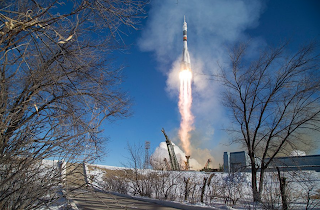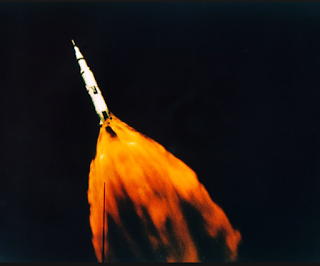Soyuz FG rocket lifts off the pad at Baikonur into a wintery blue sky.
On Sunday Dec 17, the second half of the Expedition 54 team left Russia for a two-day chase to the International Space Station. On board the Soyuz MS-07 spacecraft were Soyuz Commander Anton Shkaplerov (Roscosmos), Scott Tingle (NASA), and Norishige Kanai (JAXA). They docked at the station on Tuesday morning.
Before the launch, at the simulator (L-R): Kanai, Shkaplerov, and Tingle.
This is Shkaplerov's third trip to the ISS. This time he will take over as station commander when the current lead crew returns to Earth. FOr Kanai, though this may be his first spaceflight, he previously made a two-week stay in the seabase off the Florida coast in 2015, simulating communications protocols in a future Mars mission with long signal delays. Scott Tingle has been a Navy test pilot and also flew as a member of the elite Blue Diamonds demonstration team. He has 54 combat missions to his credit, and joined NASA in 2009. This is his first flight to space.
Current spacecraft docking locations at the ISS.
November and December have seen a busy schedule of flights to and from the station. The Cygnus resupplu spacecraft arrived on November 13 for a three week stay. After delivering its supplies, the spacecraft undocked on December 6 for a 12 day period of free-flight testing, before entering the Earth's atmosphere on December 18 for a fiery end. During that time it also launched 14 Nanorack Cubesats.
Cygnus OA-8, named SS Gene Cernan.
SpaceX launched another Dragon supply ship CRS-13 on Dec. 8. This time, both the capsule (C-108) and the Falcon 9 rocket are being used a second time, as part of SpaceX's re-usable spacecraft system. It is currently docked to the US-built Harmony module.
CRS-13 docked to the Harmony module.
On Thursday Dec. 14, Soyuz MS-05 undocked from the ISS for a return to Earth. In Command of the spacecraft was Sergei Ryazansky (Roscosmos), accompanied by Randy Bresnik (NASA) and Paolo Nespoli (ESA). Bresnik had been Commander of Expedition 53 before leaving the station in the capable hands of Misurkin, commanding Expedition 54.
Beautiful picture of returning Soyuz capsule over Kazakhstan.
Sadly, it has been reported that astronaut Bruce McCandless II has died. He was made famous around the world for the image of him in the shuttle EVA suit flying tether-free around the space shuttle. Most people are unaware, but he served as Houston Mission Control communicator during the historic moonwalk of Neil Armstrong and Buzz Aldrin on Apollo 11 in 1969. He also was part of the crew that launched the Hubble Space Telescope on STS-31 in the shuttle Discovery.
McCandless in his official NASA WSS press photograph, strapped into the Manned Maneuvering Vehicle (MMV).
One of the most famous photos of the Shuttle period, McCandless flies free in the MMV during mission STS-41B around the space shuttle Challenger.




















































